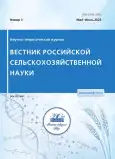Model of winter soft wheat variety for steppe condition zone
- Authors: Fomenko M.A1, Grabovets A.I1, Oleynikova T.A1, Babrovskaya E.A1, Chernousov E.V1
-
Affiliations:
- Federal Rostov Agricultural Research Center
- Issue: No 3 (2023)
- Pages: 7-12
- Section: Articles
- URL: https://journals.rcsi.science/2500-2082/article/view/147894
- DOI: https://doi.org/10.31857/2500-2082/2023/3/7-12
- EDN: https://elibrary.ru/FJDZSW
- ID: 147894
Cite item
Full Text
Abstract
About the authors
M. A Fomenko
Federal Rostov Agricultural Research Center
A. I Grabovets
Federal Rostov Agricultural Research Center
Email: grabovets_ai@mail.ru
T. A Oleynikova
Federal Rostov Agricultural Research Center
E. A Babrovskaya
Federal Rostov Agricultural Research Center
E. V Chernousov
Federal Rostov Agricultural Research Center
References
- Боровик А.Н., Беспалова Л.А., Колесников Ф.А. и др. Классика - новый сорт пшеницы мягкой озимой// Труды Кубанского аграрного университета. 2021. №91. С.33-35. doi: 10.21515/1999-1703-91-32-35
- Вавилов Н.И. Теоретические основы селекции пшеницы. М.: Наука, 1987. 506 с.
- Грабовец А.И. Донской метод определения морозостойкости и жизнеспособности озимых хлебов. Ростов-на-Дону: Юг. 2010. 23 с.
- Грабовец А.И. О модели сорта озимой мягкой пшеницы для условий Дона // Селекция и семеноводство. 1983. №2. С.10-13.
- Грабовец А.И., Фоменко М.А. Некоторые аспекты создания и выявления трансгрессивных высокопродуктивных рекомбинантов озимой пшеницы // Российская сельскохозяйственная наука. 2022. № 5. С. 3-7. doi: 10.31857/S2500262722050015
- Жученко А.А. Возможности старта российского АПК в XXI столетие//Аграрный Вестник Юго-Востока. 2009. №1. С. 6-12.
- Иванов А.Л., Эделгериев Р.Х., Донник И.М. и др. Глобальный климат и почвенный покров России: проявления засухи, меры предупреждения, борьбы, ликвидация последствий адаптационные мероприятия (сельское и лесное хозяйство)/ Национальный доклад (монография). Т.3. М.: МБА. 2021. С. 700. doi: 10.52479/978-5-6045103-9-1
- Каракотов С.Д., Карлов Г.И., Прянишников А.И., Диващук М.Г., Хверенец С.Е., Титов В.Н., Попова В.М. К использованию алгоритмов маркерной селекции для улучшения сортов озимой пшеницы/ Вестник аграрной науки. 2022. №3(96). С. 29-32. doi: 10.17238/issn2587-666X.2022.3.8
- Ковтун В.И., Ковтун Л.Н. Модель сорта мягкой озимой пшеницы интенсивного типа для условий Юга, Юго-Востока и Центрально-Черноземной зоны России//Сельскохозяйственный журнал. 2022. №1 (15). С. 13-22. doi: 10.25930/2687-1254/002.1.15.2022
- Матишов Г.Г., Дашкевич Л.В., Кириллова Е.Э. Цикличность климата в Приазовье: современный период (19-21вв)// Доклады Российской Академии наук. Науки о земле. 2021. №1. Т. 458. С. 96-100. doi: 10.31857/S2686739721050091
- Петров Л.К. Оценка урожайности, экологической стабильности и пластичности сортов озимой пшеницы// Российская сельскохозяйственная наука. 2020. №3. С. 6-9. doi: 10.31857/S2500262720030023
- Прянишников А.И., Савченко И.В., Мазуров В.Н. Адаптивная селекция: теория и практика отбора на продуктивность//Вестник Российской сельскохозяйственной науки. 2018. №3. С. 29-32. doi: 10.30850/vrsn/2018/3/29-32
- Сухоруков А.Ф., Сукоруков А.А. Совершенствование модели сорта озимой пшеницы для условий среднего Поволжья// Известия Самарского научного центра Российской академии наук. 2015. №3-4 (т. 17) - С. 473-48.
- Ahmad Z., Waraich E.A., Akhtar S., Anjum S., Ahmad T., Mahboob W., Hafeez O.B.A., Tapera T., Labuschagne M., Rizwan M. Physiological responses of wheat to drought stress and its mitigation approaches// Acta Physiologiae Plantarum. 2018. 40: 80 doi: 10.1007/s11738-018-2651-6
Supplementary files










